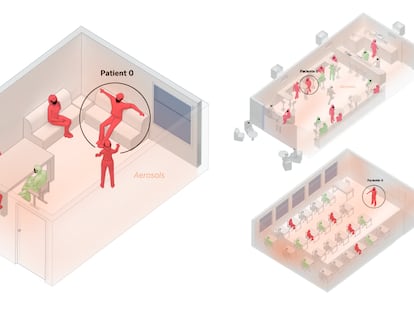More than 500 separate entries: How Spain’s coronavirus nightmare began
A new report on the virus’ genome shows that there was no “patient zero,” and argues the impact of the pandemic would have been reduced with early restrictions on movement

Bible experts know how important printing errors are in establishing how old a copy is. The royal printers of London, for example, omitted the word “not” in 1631 when they copied the seventh commandment, which was published as follows: “Thou shalt commit adultery.” Any researcher seeing the omission would immediately recognize the so-called “adulterous bible” of the 17th century.
Like the Bible publishers of the past, the coronavirus is very good at making copies of itself, but it also occasionally makes mistakes when transcribing the 30,000 chemical letters of its genome. This allows scientists inspecting those mistakes to reconstruct its history. An October coronavirus is about 20 mutations away from the first ones studied at the beginning of the pandemic.
A genetic analysis of 2,170 coronavirus patients – the largest one to date – has identified at least 519 independent entries of the virus into Spain during the first wave of the pandemic, most of them from mid-February. The researchers indicate that “multiple entries” came via Valencia following the February 19 soccer match between Atalanta and Valencia in Milan, which was attended by about 2,500 Valencia fans. The scientists also suggest that Milan Fashion Week, held from February 18 to 24, played a significant role as did the international contemporary art fair ARCO in Madrid, which opened on February 27 in Madrid’s IFEMA convention center, the same venue that would be converted into a field hospital for Covid patients a month later.
Only one other country in Europe and three others in the world have sequenced more of the virus’ genomes than Spain
“Patient zero doesn’t exist,” stresses the report by SeqCOVID, a team of researchers led by biologist Iñaki Comas, from the Valencia Institute of Biomedicine (IBV). The team’s research identifies two genetic signatures, referred to as SEC7 and SEC8, as “the main groups causing the epidemic in Spain,” given they were responsible for the highest number of infections – 10% and 30%, respectively.
SEC8 represented 60% of the sequenced cases in the first weeks of March. Both genetic families correspond to strains circulating in China at the start of the pandemic. “This suggests that the virus was introduced to Spain very early on,” according to the report, which explains that the rest of Europe was affected by later strains of the virus.
The European Center for Disease Prevention and Control had already warned on January 18 that Wuhan airport in China had six direct flights a week to Paris, three to Rome and three to London. The Spanish government declared a state of alarm on March 14, confining millions of people to their homes while enforcing border controls. But, the report argues: “Tighter border control, coupled with early and local restrictions on movement, would likely have limited the expansion of SEC8 and thus the epidemic in Spain.”
The report also points out that the earliest case of Covid-19 in Spain was that of a 69-year-old man who returned from a trip to Nepal on January 30 and died on February 13 from pneumonia in a hospital in Valencia. “However, the identification of an early case does not imply that the patient in question is the generator or instigator of the pandemic in Spain. In fact, neither our epidemiological studies nor our analyses suggest that this patient caused any secondary cases,” says the report, which adds that the Nepal case left no trace.
Iñaki Comas' team has cross-referenced the results of their genomic analysis with the scarce epidemiological data available in order to try to explain, “how a few cases can become thousands in just a few weeks.” Their report notes that the SEC8 strain was introduced from Italy via Valencia and Madrid and possibly other cities early on and spread rapidly thanks to several “super-spreading local events” such as a funeral in the Basque city of Vitoria on February 23, which triggered more than 60 infections among those attending and their close contacts.
Tighter border control, coupled with early and local restrictions on movement, would likely have limited the expansion of SEC8 and thus the epidemic in SpainSeqCOVID report
Surprisingly, the SEC8 strain of the virus does not have the D614G mutation – a change of a single letter of the virus’ genome that some scientists believe might make it more contagious. “We have not detected any specific mutation [linked to increased transmission],” says Comas. “The success of a mutation has more to do with opportunity: being in the right place at the right time.”
These dominant genetic strains present in the first wave are now residual. “Virtually all of them have been stamped out, suggesting the lockdown was a success,” says the report’s authors, in reference to the strict home confinement measures introduced under the state of alarm. The researchers now have preliminary data on new strains that have replaced those in the first wave.
Only one other country in Europe and three others in the world have sequenced more of the virus’ genomes than Spain, largely thanks to the SeqCOVID consortium, directed by Iñaki Comas and the geneticist Fernando González Candelas, a professor at the University of Valencia. However, their results have been slow to arrive, as Comas himself acknowledges. “Everyone has been late in this pandemic, including us with this report,” he says.
By way of an explanation, the report lists a series of problems that prevented the rapid generation of data: “Real-time information, as exists in the United Kingdom, requires available staff who are dedicated full time to generating reports. Due to lack of budget, SeqCOVID does not have that staff,” says the report, whose letterhead includes the logos of the National Research Institute (CSIC) and Science Ministry.
Comas' team also complains about the lack of access to patient samples as hospitals were overwhelmed during the first wave of the pandemic. This problem made it particularly difficult to access epidemiological data – for example, where these patients were and who they were with before they contracted the disease. “We only have a limited number of variables collected for most cases,” says the report. “Linking these cases to epidemiological data is almost impossible given the wide variety of institutions that are necessarily involved in obtaining them.”
Meanwhile, Comas points out that Spain has no structure for the epidemiological surveillance of genomes and calls on the authorities to aim to achieve “real-time” monitoring.
English version by Heather Galloway.
Tu suscripción se está usando en otro dispositivo
¿Quieres añadir otro usuario a tu suscripción?
Si continúas leyendo en este dispositivo, no se podrá leer en el otro.
FlechaTu suscripción se está usando en otro dispositivo y solo puedes acceder a EL PAÍS desde un dispositivo a la vez.
Si quieres compartir tu cuenta, cambia tu suscripción a la modalidad Premium, así podrás añadir otro usuario. Cada uno accederá con su propia cuenta de email, lo que os permitirá personalizar vuestra experiencia en EL PAÍS.
¿Tienes una suscripción de empresa? Accede aquí para contratar más cuentas.
En el caso de no saber quién está usando tu cuenta, te recomendamos cambiar tu contraseña aquí.
Si decides continuar compartiendo tu cuenta, este mensaje se mostrará en tu dispositivo y en el de la otra persona que está usando tu cuenta de forma indefinida, afectando a tu experiencia de lectura. Puedes consultar aquí los términos y condiciones de la suscripción digital.
More information
Últimas noticias
Half of Scotland is in the hands of 420 property owners
Pinochet’s victims grapple with José Antonio Kast’s rise in Chile
Reinhard Genzel, Nobel laureate in physics: ‘One-minute videos will never give you the truth’
From digital curfews to blocking apps: How technology experts protect their children online
Most viewed
- Pablo Escobar’s hippos: A serious environmental problem, 40 years on
- Reinhard Genzel, Nobel laureate in physics: ‘One-minute videos will never give you the truth’
- Why we lost the habit of sleeping in two segments and how that changed our sense of time
- Charles Dubouloz, mountaineering star, retires at 36 with a farewell tour inspired by Walter Bonatti
- The Florida Keys tourist paradise is besieged by immigration agents: ‘We’ve never seen anything like this’











































